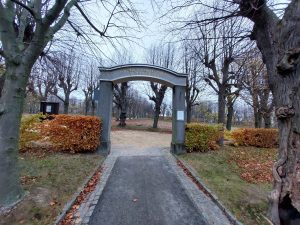Anna travelled widely, like many Moravians from the 1730s onwards. Here we look at some of her travels and the impact she had on those she met. With regard to the picture, clearly Anna did not travel with a teddy bear; however, on my travels in the search of Moravian history I am always accompanied by a bear.
Off to America
On her travels, equality and leadership shone through. Today her legacy as an early philanthropist is valued in America where her work is still recognised at the Bethlehem Moravian University, Pennsylvania. The Anna Nitschmann Society at the University provides support for young women as they develop their leadership and influencing skills today.
She initially went out to Pennsylvania at the invitation of Spangenberg[1]. He was working with settlers and others there and wrote to a colleague in Herrnhut stating that Anna was the most likely person to help them overcome their differences. He believed she would influence the women and help them come together in a shared faith. This reflects back to her early work in Herrnhut with the young girls.
Off to Fulneck
Anna became the second wife of Count Zinzendorf. This is an amazing change in her life considering that she was a refugee as a child, leaving Moravia with her family. With Count Zinzendorf she visited Fulneck Moravian settlement in Yorkshire. Anna was one of only two people to visit Fulneck, having left the Fulnek estate in Moravia. The other was Teltschik. He had left left Suchdol in 1722, one of the first five young men who left due to religious persecution and who went on to help build Herrnhut, Saxony, at the invitation of Count Zinzendorf. Teltschik laid the foundation stone for the church at Fulneck, Yorkshire, in 1746.
A scattered family
Anna was not the only member of her family to travel widely in the service of the church. Her family are buried far and wide, showing the extent of their travels. Places her family are buried: her father David (1758) Bethlehem, Pennsylvania; her mother Anna (nee Schneider: 1735) in the West Indies; her brother John (1783) in Sarepta, Russia; Brother Melchoir (1729) Moravia; her sister Rosalina (1731) and Anna (1760) in Herrnhut.

Map of the world.
 Herrnhut: the entrance to God’s Acre where Roalina and Anna are buried.
Herrnhut: the entrance to God’s Acre where Roalina and Anna are buried.
Many friends, many farewells
Moravian hospitality is famous and I am confident that Anna will have made many friends on her travels. Due to the challenges of travelling back then, she will often have left knowing a return was highly unlikely. Hence many farewells.
Which brings me to a personal message. Now I am saying ‘farewell’. I judge it is time to end my telling of this story and also, in a few months, to close the website.
I will continue to do my talks for charity and would encourage you to share my details with anyone who books speakers for a group. I invite donations and every penny goes to charities. At the talks I explain which charities and why they are chosen. I offer a talk about Elizabeth Wolstenholme Elmy, the early Victorian feminist who influenced many of our laws; I now have various new talks about my travels and Moravian history, each story with a twist, layers of history and plenty of cake along the way! Each talk is supported by my love of research and finding those hidden nuggets of interest, often relating to the women whose story is often not being told. So, whatever a group is interested in I would hope to have a topic to engage and interest them.
I am happy to travel and can come along with the relevant equipment.
Please pass on my email: mary@woodhall28.co.uk
To everyone who has bought my book and donated to my talks, a huge thank you. You have helped me raise thousands of pounds. I am always keen to revisit a group so please invite me back.
Over the coming months I will be sharing my interests and thoughts on Facebook so please follow me at mary.holmes28
Finally, thank you for reading my posts and I hope they have been of interest.
Mary Holmes
[1] Spangenberg was a minister and bishop in the Moravian Church. He was working in Pennsylvania to bring various groups to the Moravian faith.


Recent Comments